Abstract
Plants adopt several strategies to acquire phosphorus (P) under P deficient conditions. Exudation of organic acids and synthesis of certain enzymes involved in the solubilization of bound P in the soil are among the important strategies. We investigated the involvement of organic acids and acid phosphatase in acquiring P under deficient conditions. In our earlier experiments we classified Pigeon pea genotypes, as high and low P uptake types based on root dry weight and P content of the leaves. Here we report that the root exudates of high P uptake genotypes had higher organic acids, indicated by higher P solubilization capacity of these genotypes. Further, the acid phosphatase activity was also higher in these genotypes under P deficient conditions compared to low P uptake types. There was an inverse relationship between root P content, P solubilisation capacity and root acid phosphatase activity. Differences in P uptake are attributed to root characteristics and altered plant metabolism to cope with P stress. We also report here a novel technique for the measurement of root surface area using nitrite assay method.





Similar content being viewed by others
References
Ae, N., Arihara, J., Okada, K., Yoshihara, T., & Johansen, C. (1990). Phosphorus uptake by pigeon pea and its role in cropping systems of the Indian subcontinent. Science, 248, 477–480.
Ansari, S. A., Kumar, Pramod, & Gupta, B. N. (1995). Root surface area measurements based on adsorption and desorption of nitrite. Plant and Soil, 175, 133–137.
Applet, H., Coleman, N. T., & pratt, P. F. (1975). Interactions between organic compounds, mineral and ions in volcanic-ash derived soils.II.Effects of organic compounds on the adsorption of phosphate. Soil Science Society of America Journal, 39, 628–630.
Arun, N. (2012). Identification of pigeon pea genotypes for high phosphorus uptake through acid phosphatase activity: A biochemical approach. M.Sc (Agric) thesis in Crop Physiology, UAS, GKVK, Bangalore.
Barber, S. A. (1980). Soil-Plant interactions in phosphorus nutrition of plants. In F. E. Khasawneh, E. C. Sample, & E. J. Kamprath (Eds.), Role of phosphorus in agriculture (pp. 591–615). Madison, WI: American Society of Agronomy.
Bates, T. R., & Lynch, J. P. (2001). Root hairs confer a competitive advantage under low phosphorus availability. Plant and Soil, 236, 243–250.
Bradford, M. M. (1976). A rapid and sensitive method for the quantitation of microgram quantities of protein utilizing the principle of protein-dye binding. Analytical Biochemistry, 72, 248–254.
Dinkelaker, B., Hengeler, C., & Marschner, H. (1995). Distribution and function of proteoid roots and other root clusters. Botanica Acta, 108, 183–200.
Dinkelaker, B., Römheld, V., & Marschner, H. (1989). Citric acid excretion and precipitation of calcium citrate in the rhizosphere of white lupin (Lupinus albus L.). Plant, Cell and Environment, 12, 285–292.
Dunlop, J., Lambert, M. G., Van den Boser, J., Caradus, J. R., & Hart, A. L. (1990). A programme to breed a cultivar of Trifolium response L for more efficient use of PO4. In N. E. I. Bassam, M. Dambrolth, & B. C. Loughman (Eds.), Genetic aspects of plant mineral nutrition (pp. 547–552). Dodrecht: Kluwar Academic Publishers.
Estrella, L. H., Bucio, J. L., & Grierson, C. (2001). Molecular characterization of the effects of phosphorus on the development of root hairs in Arabidopsis. Plant Nutrition, 92, 20–21.
Fitter, A. H., & Hay, R. K. M. (2002). Environmental physiology of plants. London: Academic Press.
Fox, T. R., Conleford, N. B., & McFee, W. W. (1990). Phosphorus and aluminium release from spoidic horizon mediated by organic acids. Soil Science Society of America Journal, 54, 1763–1767.
Gahoonia, T. S., & Nielsen, N. E. (1998). Direct evidence on participation of root hairs in phosphorus (32P) uptake from soil. Plant and Soil, 198, 147–152.
Gahoonia, T. S., & Nielsen, N. E. (2004). Barley genotypes with long root hairs sustain high grain yields in low-P field. Plant and Soil, 262, 55–62.
Gardner, W. K., Barber, D. A., & Parberry, D. G. (1983). The acquisition of phosphorus by Lupinus albus L. III. The probable mechanism by which phosphorus movement in the soil/root interface is enhanced. Plant and Soil, 70, 107–124.
Gerke, J., Römer, W., & Jungk, A. (1994). The excretion of citric and malic acid by proteoid roots of Lupinus albus L.; effect on soil solution concentrations of phosphate, iron, and aluminum in the proteoid rhizosphere in samples of an oxisol and a luvisol. Zeitschrift fur Pflanzenernahrung und Bodenkunde, 157, 289–294.
Hocking, P. J. (2001). Organic acids exuded from roots in phosphorus uptake and aluminum tolerance of plants in acid soils. Advances in Agronomy, 74, 63–97.
Hocking, P. J., Keerthisinghe, G., Smith, F. W., & Randall, P. J. (1997). Comparison of the ability of different crop species to access poorly-available soil phosphorus. In T. Ando, K. Fujita, T. Mae, H. Matsumoto, S. Mori, & J. Sekiya (Eds.), Plant nutrition for sustainable food production and environment, Proc 13th Int plant nutrition colloq (pp. 305–308). Dordrecht: Kluwer Academic Publishers.
Jackson, M. L. (1967). Phosphorus determination for soils. In Soil chemical analysis. pp 134–182.
Johnson, W. B., & Olsen, R. A. (1972). Dissolution of fluorappatite by plant roots. Soil Science, 11, 429–436.
Keerthisinghe, G., Hocking, P. J., Ryan, P. R., & Delhaize, E. (1998). Effects of phosphorus supply on the formation and function of proteoid roots of white lupin (Lupinus albus L.). Plant Cell Environ, 21, 467–478.
Kepert, D. G., Robson, A. D., & Posnor, A. M. (1979). The effect of organic root products on the availability of phosphorus to plants. In J. L. Harley & R. S. Russell (Eds.), The Soil Root Interface (pp. 115–124). Newyork: Academic Press.
Kouas, S., Debez, A., Slatni, T., Labidi, N., Drevon, J. J., & Abdelly, C. (2009). Root proliferation, proton efflux, and acid phosphatase activity in common bean (Phaseolus vulgaris) under phosphorus shortage. Journal of Plant Biology, 52, 402–495.
Krasilnikoff, G., Gahoonia, T. S., & Nielsen, N. E. (2003). Variation in phosphorus uptake efficiency by genotypes of cowpea (Vigna unguiculata) due to differences in root and root hair length and induced rhizosphere processes. Plant and Soil, 251, 83–91.
Li, M., Shinano, T., & Tadano, T. (1997). Distribution of exudates of Lupine roots in the rhizosphere under phosphorus deficient conditions. Soil Science and Plant Nutrition, 43, 237–245.
Li, J., Xie, Y., Dai, A., Liu, L., & Li, Z. (2009). Root and shoot traits responses to phosphorus deficiency and QTL analysis at seedling stage using introgression lines of rice. Journal of Genetics and Genomics, 36(3), 173–183.
Mollier, A., & Pellerin, S. (1998). Maize root system growth and development as influenced by phosphorus deficiency. Journal of Experimental Botany, 50(333), 487–497.
Murphy, J., & Riley, J. P. (1962). A modified single solution method for the determination of phosphate in natural waters. Analytica Chimica Acta, 27, 31–36.
Nye, P. H. (1984) pH changes and phosphate solubilisation near roots-An example of coupled diffusion process. In: S. A. Barber & D. R. Boulding (Eds.), Roots,nutrient and water-influx,and plant growth M (pp. 79–100). Madison: ASA spl.Publ.49.
Ohwaki, Y., & Hirata, H. (1992). Differences in carboxylic acid exudation among P-starved leguminous crops in relation to carboxylic acid contents in plant tissues and phospholipid level in roots. Soil Science and Plant Nutrition, 38, 235–243.
Raghothama, K. G. (1999). Phosphate acquisition. Annual Review of Plant Biology, 50, 665–693.
Ryan, P. R., Delhaize, E., & Jones, D. L. (2001). Function and mechanism of organic anion exudation from plants. Annual Review of Plant Biology, 52, 527–560.
Schactman, D. P., Reid, R. J., & Ayling, S. M. (1998). Phosphorus uptake by plants: From soil to cell. Plant Physiology, 116, 447–453.
Steingrobe, B. (2001). Root renewal of sugar beet as a mechanism of P uptake efficiency. Journal of Plant Nutrition and Soil Science, 164, 533–539.
Steingrobe, B., Schmid, H., & Claassen, N. (2001). Root production and root mortality of winter barley and its implication with regard to phosphate acquisition. Plant and Soil, 237, 239–248.
Stitt, M., & Rudiger-Scheible, W. (1998). Understanding allocations to shoot and root growth will require molecular information about which compounds act as signals for the plant nutrient status, and how meristem activity and cellular growth are regulated:Opinion. Plant and Soil, 201, 259–263.
Subbarao, G. V., Ae, N., & Otani, T. (1997). Genotypic variation in iron-, aluminum- phosphate solubilizing activity of the pigeonopea root exudates under P deficient conditions. Soil Science and Plant Nutrition, 43, 295–305.
Tabatabai, M. A., & Bremner, J. M. (1969). Use of p-nitorophenyl phosphate for assay of soil phosphatase activity. Soil Biology & Biochemistry, 1, 301–307.
Tadano, T., & Sakai, H. (1991). Secretion of apase by the roots of several crop species under phosphorus deficient conditions. Soil Science and Plant Nutrition, 37, 129–140.
Tomascha, J. L., Trull, M. C., Deikman, J., Lynch, J. P., & Guiltinan, M. J. (2004). Phosphatases under P producer mutants have cultured P relations. Plant Physiology, 135, 334–345.
Triana, S. J., Sposito, G., Hesterberg, D., & Kafkin, U. (1986). Effect of pH and organic acids on orthophosphate solubility in an acidic montmorillonic soil. Soil Science Society of America Journal, 50, 45–52.
Xu, R. K., Zhu, Y. G., & Chittleborough, D. (2004). P release from phosphate rock and iron phosphate by low molecular weight, organic acids. Journal of Environmental Science, 61(1), 5–8.
Author information
Authors and Affiliations
Corresponding author
Rights and permissions
About this article
Cite this article
Krishnappa, R., Aftab Hussain, I.S. Phosphorus acquisition from deficient soil: involvement of organic acids and acid phosphatase in pigeon pea (Cajanus cajan L. mills sp). Ind J Plant Physiol. 19, 197–204 (2014). https://doi.org/10.1007/s40502-014-0101-z
Received:
Accepted:
Published:
Issue Date:
DOI: https://doi.org/10.1007/s40502-014-0101-z




